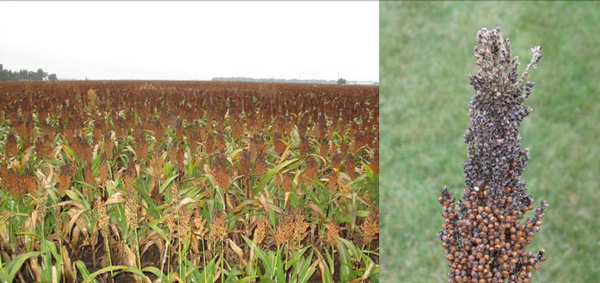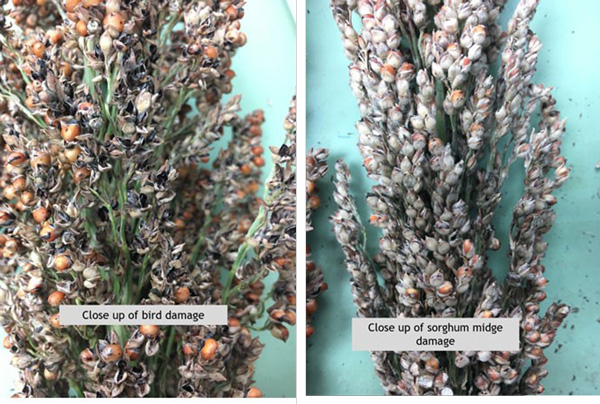This year in Kansas, several grain sorghum fields exhibit heads that are partially blank or have very small kernels, often affecting the upper portion of the head, although other parts are sometimes involved (Figure 1).

Figure 1. Field in Reno County (photo taken in a previous growing season). The upper third of the heads is blank and darkened throughout the field. Photos by J. Shroyer, K-State Research and Extension.
There are a number of possible causes:
Unusually cool weather at or near the time of pollination: Studies have shown that cool temperatures during pollen formation can induce male sterility. Pollen formation typically begins as the flag leaf emerges and continues until flag leaf collar development (near the boot stage), well before heading and pollen shed. Night temperatures at or below 55°F during these critical stages can drastically reduce seed set. Poor seed set this season may be related to cool night temperatures that occurred when pollen was forming, around the time of flag leaf emergence.
Once pollination begins, temperatures near 50°F can slow pollen germination and growth. Formed pollen can survive at temperatures below 40°F and remain viable until warmer daytime temperatures allow successful germination. However, cool conditions can still reduce seed set by slowing pollen tube growth to the ovule.
Sorghum flowers from the top of the head downward over several days. Occasionally, a band of poor seed set is observed if pollen shed or growth is inhibited for just one or two days. Because new pollen is shed each day, normal fertilization usually resumes unless cool temperatures persist for a week or more.
Application of a growth regulator herbicide: Applying growth regulator herbicides such as dicamba or 2,4-D beyond the labeled height restriction can cause partial or total head sterility. Heads affected by this type of injury often show twisting or distortion.
Bird damage: Bird damage is common and typically occurs most severely near tree lines or fences. Damage is usually obvious, with hollowed-out or “blasted” areas where kernels were removed (Figure 2). Droppings on leaves or the soil surface are additional signs.

Figure 2. Bird damage on a sorghum head (left) can be mistaken for midge damage (right). Bird feeding gives the head a “blasted” appearance. Sorghum midge damage appears as blank zones on the flowering head. Photos by Anthony Zukoff, K-State Research and Extension.
Insect damage: Sorghum midges damage grain by laying eggs during flowering. The larvae feed on developing kernels, each typically destroying one seed. The adult midge is a tiny, red, gnat-like insect attracted only to heads (or parts of heads) that are flowering.
No kernel develops inside glumes where larval feeding occurs, giving the glumes a flattened appearance. Midge damage is often confused with bird damage (Figure 2). After feeding, larvae crawl to the top of the spikelet to pupate. When adults emerge, they leave behind small, weather-resistant pupal cases that may still be visible.
Infested heads usually contain normal kernels scattered among empty spikelets, since midges rarely infest every kernel. Adults live about one day and lay roughly 45 eggs. Although sorghum midges were historically limited to the southeast quarter of Kansas, they have expanded their range and now cause yield losses in late-planted sorghum across the southern two-thirds of the state.
Diseases and freeze injury
Diseases are unlikely to be the cause of head blanking. While the affected areas often appear darkened or moldy, these symptoms are due to saprophytic fungi that colonize the heads after damage has occurred.
Freeze injury is also not responsible. If no kernels are present, the problem originated during pollination and fertilization. Very small kernels indicate an issue early in the grain-filling period. In either case, the damage occurred well before hard freezes.
Most likely cause this year
In 2025, the most likely cause of blank or partially blank heads is unusually cool conditions during pollination, especially in fields where the issue occurs uniformly.
Table 1. Lowest recorded temperatures for the month of August 2025 for selected locations in Kansas.
|
Location |
Date |
Temperature (°F) |
|
Colby |
August 31 |
54.4 |
|
Hays |
August 26 |
53.5 |
|
Tribune |
August 4 |
56 |
|
Garden City |
August 4 |
57.6 |
|
Hutchinson |
August 26 |
52.8 |
|
Belleville |
August 26 |
49.6 |
|
Manhattan |
August 26 |
52.7 |
|
Parsons |
August 27 |
53.1 |
Sorghum begins flowering and pollinating at the top of the head and progresses downward over several days. If cool conditions persist for only one or two nights, only part of the head, or one side, may be affected. This pattern matches what has been observed in many Kansas fields this year.
Lucas Haag, Agronomist-in-Charge, Tribune
lhaag@ksu.edu
Logan Simon, Southwest Area Agronomist
lsimon@ksu.edu
Anthony Zukoff, Instructor of Entomology
azukoff@ksu.edu
Tina Sullivan, Northeast Area Agronomist
tsullivan@ksu.edu
Jeanne Falk Jones, Northwest Area Agronomist
jfalkjones@ksu.edu
Tags: sorghum grain sorghum blank heads